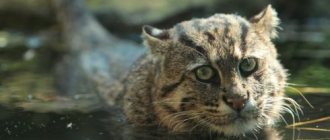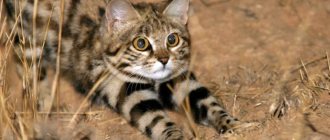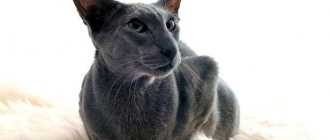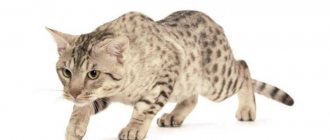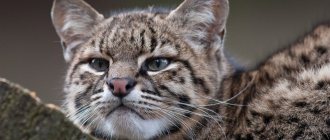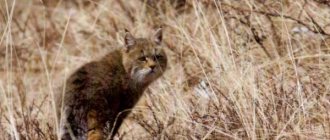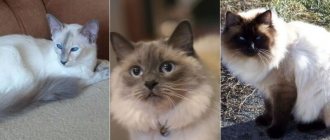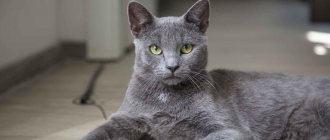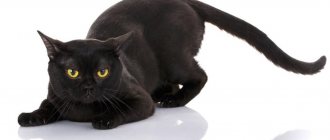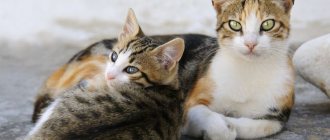Temminck's cat is rightfully one of the little-studied and rare animals of our planet. This is not an artificially bred breed or one formed as a result of natural selection, but a wild variety.
The population of this animal in natural conditions is small, and not all, even very well-known, zoos can boast that they have this rare and beautiful animal, with which many amazing legends of Asian peoples are associated.
The history of the Temminki cat
Golden Asian cats were first discovered in the late 19th century by Dutch explorer Conrad Jacob Temminck. The species itself was named after this scientist.
This discovery is unusual, since the zoologist believed that he had met African golden cats in the Asian forests and it was precisely how Temminok first described these animals.
Today this predator has several names - Asian Golden, Temminka's Cat, Fiery, Fire Cat.
In its morphology, the animal is very similar to a puma, although much smaller and of a different color.
Wild cat diet
The Temminck cat is a typical predator, so its main food is fresh meat. The animal hunts mainly large birds, gophers, rats and other rodents, but its diet may also include large species of reptiles and amphibians and even insects. In addition, young specimens of artiodactyl mammals (young deer, etc.) often become the food of this predator.
Did you know? The international name Temminck's cat was given by the British scientist and naturalist Thomas Horsfield in 1827.
Description and natural habitat
Temminka was originally classified as a member of the golden cat family, but today this classification has been abolished. The beast is considered a catopuma and is a descendant of Kalimantan or Barneo cats.
This is a fairly large animal, at least twice the size of a regular domestic cat. The average length from the nose to the tip of the tail is 90-95 cm. A strong muscular body with powerful paws is covered with thick short hair of brown or golden shades, although there are also melanistic cats in natural gray or black tones. The color is more of a tabby, although the golden hairs are ticked. The body may have sparse spots and streaks, and the muzzle has characteristic charcoal-white stripes.
The natural range of this animal is quite wide - from the foot of the Himalayas to the southern edges of the Chinese border and the Indochina Peninsula, although some species are also found in Sumatra. For the most part, this species inhabits mountain forest biotopes. The Temminka cat can be found in the subtropical and tropical zones of evergreen forests of the following countries - Thailand, Nepal, Malaysia, Bangladesh, Myanmar, India, Bhutan, Vietnam, Laos, Cambodia.
Sometimes this wild cat also appears on coffee plantations and open forest areas.
Depending on the region where it lives, the size of the Temminka Cat varies greatly. The smallest specimens barely reach 60 cm in length, and the largest ones are more than a meter. Height at the withers is from 35 to 55 cm. Weight ranges from 10 to 17 kg.
The head is not particularly large compared to the powerful body with fairly long and strong legs.
The eyes are not too large and not very wide apart. They are often brownish or golden in color. The nose is wide and large with a large, brick-colored nose.
The ears are medium in size with slightly rounded tips and set quite high.
The tail is long, up to 50 cm, wide at the base and slightly tapering to a rounded tip.
The coat is short, dense and hard, the skin has well-developed sebaceous glands. Therefore, each hair is covered with a layer of lubricant, which protects the animal in mountainous areas from overheating and hypothermia during sudden temperature changes.
If we talk about the most common natural color, the general background color can be described as golden yellow or reddish. The mask on the face, characteristic of any predator of the feline order, makes the Temminka Cat a very expressive and bright animal due to the black and white clear lines that run along the cheeks, earpieces, forehead, and encircle the eyes.
The chest, abdominal area, inner side of the paws are of a lighter, almost beige shade, more like “coffee with milk”.
A dark brown stripe runs along the back to the tip of the tail.
In the rays of the sun, the animal’s fur actually shimmers, as if drenched in molten gold, which is why the animal is called the Fire Cat.
Norwegian Forest Cat
Forest beauty
The guardian of the Norwegian forests, who accidentally caught the eye of people. So says the ancient legend telling about the representatives of the breed.
If one of the cats guarding the forest had not gaped, the world would never have known about this breed. Beautiful animals with unusual personalities have managed to make numerous cat fans fall in love with them. Keeping a Norwegian Forest cat is considered prestigious; representatives of this breed are too good.
By themselves, “Norwegians” are large – their weight is 6-9 kg. Their thick fur gives them large volumes, making the purr look like a fur ball. In fact, a muscular body is hidden under a layer of fur.
Representatives of the breed are quite calm and friendly. They are silent people who adore heights. When thinking about purchasing a Norwegian forest cat, you should consider its habitat. These beauties love all kinds of shelters; a house with a high scratching post will be an excellent gift for a Norwegian forest cat.
Mr. Cat Warns: Difference from African Golden Cat and Species
The discovery of Temminka's Cat is associated with a scientific incident, despite this, the animal has no family ties with the African golden cat.
African golden cat
Scientists explain some external similarities by convergent evolution; similar characteristics in this case are formed in unrelated groups of animals independently of each other under similar natural living conditions.
Catopuma temminckii lives in Asia. The African golden cat Profelis aurata or Caracal aurata lives in the humid tropics of Equatorial Africa.
In size and color, the animals of both species are extremely similar, only the golden cats living in the central African region have practically no spots in color, only sparse markings on the sides.
The Temminka Cat has three subspecies:
- Catopuma temminckii temminckii live in the Himalayas, Nepal, Malaysia, and Sumatra. These individuals have the shortest coat and a thick, rich reddish color.
- Catopuma temminckii dominicanorum are found primarily in southeastern Chinese provinces.
- Catopuma temminckii tristis - inhabitants of Tibet and the northern regions of Burma.
Catopuma temminckii temminckii
Catopuma temminckii dominicanorum
Catopuma temminckii tristis
In China and Thailand, there are many beliefs about this rare animal. It is believed that Temminka's golden hair will protect the hunter from attacks by tigers. This is connected with the legend of a brave golden cat who single-handedly defeated a huge striped predator.
In many remote villages, in order to scare tigers away from attacking livestock, the fur of the Temminck Cat is still burned in the vicinity of the settlement.
For many years, the Asian Golden Cat was mercilessly exterminated, since its meat is considered a local delicacy, and many internal organs and skeleton were used by healers to make potions, mainly to treat fever in infants.
Today, the natural populations of this rare animal have been significantly reduced due to the deforestation of tropical forests; the total number of Temminki Cats is believed to be only about ten thousand individuals, although observations of this predator are difficult due to their secretive and rather shy nature.
Nevertheless, on the territory of modern Thailand, two Golden Cats were caught and equipped with collars with radio transmitters. Observation of ringed animals made it possible to establish that individuals spend the lion's share of their time in forest thickets and only about 5% in open areas.
Today, the Temminck Cat is listed in the International Red Book; they are trying to breed animals in the world's best zoos and tropical reserves.
Features of temperament
The Temminka Cat has no enemies in the wild, as it is a very cautious and even timid animal, and also an extremely intelligent hunter.
The almost complete disappearance of this beautiful cat from the face of our planet is on human conscience. Temminka never attacks first; when meeting people, she prefers to retreat and hide in the forest thickets. The exception is when the mother guards the den with kittens. In this case, the female will desperately defend her offspring and fearlessly rush at the person with a menacing roar and a specific squeal. Despite its not very large size, the predator is capable of causing significant injuries due to its sharp, strong claws and large fangs.
Temminki, like most average wild cats, live alone, are excellent at climbing trees, but still spend most of their time on the ground. This is a territorial predator that does not allow relatives into its zone, protects its possessions, marking them with physiological secretions and scratches on tree trunks.
An adult male is able to control up to 50 square meters. km. area, female – up to 35.
Being a crepuscular animal, Temminka's Cat is most active in the early morning and evening. The lifestyle of small populations may vary depending on their preferred prey.
During cloudy and rainy periods, Temminki can hunt around the clock, covering up to 5-7 km per day.
This is an excellent hunter with amazing eyesight and a keen sense of smell, who is able to almost silently get close to his prey and wait for the right moment in the bushes for many hours.
It has a powerful jump and usually kills prey by breaking the neck and biting the back of the head. The Asian golden cat is not able to run for a long time and quickly, so it does not pursue fast-moving animals. They never kill prey for reserve, they eat only fresh meat, so they go out hunting every day and never return to the den without lunch.
They usually spend the night in trees, making a den in large hollows. Cats living in the Himalayas often create burrows abandoned by other animals in rock crevices or between tree roots.
How to choose a cat breed
When choosing a kitten for your home, it is advisable to proceed from the characteristics and interests of the family, the presence of other pets, small children, and allergy sufferers. For a village or country house, ratcatcher cats are required. In an animal for an apartment, first of all, communication skills, the ability to get along with people, and a calm disposition are important.
Criterias of choice
Basic criteria for choosing a cat breed:
- owner's lifestyle;
- difficulty of care and maintenance;
- character;
- unusualness.
The owner's lifestyle. Busy working people, single pensioners, families with children should choose different purebred pets based on their usual lifestyle and time for a tailed pet.
- Independent cats that tolerate loneliness well in the absence of the owner - British Shorthair, Scottish Fold, Maine Coon. They do not require unnecessary attention, do not bother you if you are not in the mood, they will find something to do for themselves or will sleep peacefully on their favorite bed.
- If you want to buy a pet for a child, then it is appropriate to focus on kind, patient breeds that are able to leniently tolerate children's pranks and engage in joint games. Most often, playful lovers of pranks with an easy-going character are chosen for children: Norwegian Forest, Siamese, Bengal.
- A lonely person lacks communication; such people choose cats that are affectionate, loyal, affectionate and sociable. It will be nice to while away long evenings with them, talk about everything, sit in an embrace on a soft sofa. Affectionate, talkative breeds: Thai, Bengal, Cornish Rex.
- For a private home, it is better to choose a cat with a good hunting instinct to fight rodents. American Shorthair, Siberian, and Scottish Fold will be excellent at exterminating mice and rats.
- If the family already has pets, cats or dogs, then an American Bobtail, Thai, or Himalayan are ideal partners. They are friends with dogs, willingly play with other cats, sleep together, lick each other.
Difficulty in care and maintenance. Depending on its characteristics, each cat breed requires more or less attention and time for care, and is simple or difficult to maintain.
- The easiest to care for are unpretentious in food, without thinking through the daily menu, and short-haired pets that do not require combing or daily cleaning of the apartment when shedding.
- If you have the time and desire to carefully care for your tailed pet, then long-haired breeds, which often shed and require constant care for their fur, are ideal, as well as hairless breeds, whose representatives need to create a special temperature regime, constantly freeze or sweat, and therefore have to wash frequently.
- Difficult in keeping can also include the Persian with a specific flat muzzle, due to the structure of which diseases are often possible, the Scottish Fold with special care for unusually shaped ears, all varieties of Sphynx - hairless cats, which must be carefully warmed, without allowing thermal blows from overheating.
Character. Each breed of cat leaves its mark on the character of the animal, its temperament and disposition.
- There are talkative and sociable dogs that are suitable for those who are used to having philosophical conversations and cannot tolerate oppressive silence in the house: Canadian Sphynx, Siamese, Thai.
- The list of silent felines for which meowing is the exception rather than the rule includes the Cornish Rex, Siberian, and American Shorthair. They are turned on by people who value tranquility and who are irritated by unnecessary sounds.
- Active, active tailed cats, constantly in motion and exploring space, the owner will have to constantly come up with new activities, although they often find them themselves by examining the contents of cabinet drawers, shelves and racks. Prominent representatives of restless cats: Bengal, Abyssinian.
- The list of the laziest is headed by the British, Persian, and Siberian. It is important for them to eat heartily and sleep to their heart’s content. Sometimes owners may even forget about their presence in the house, the cats spend so much time in the kingdom of Morpheus.
- Loving people will be delighted with the most affectionate cats that constantly follow their owner in anticipation of hugs and other tenderness: Sphynx, Ragdoll, Burmese. You should only get them if you are ready to give your pet a lot of attention and affection.
- Intelligent breeds that are easy to train, understand human speech, and can learn simple commands. Smart cats - Siamese, Oriental, American Bobtail.
Unusuality. If the main thing for you in a cat is its unusual appearance, and you are willing to overpay for this, since the average price is quite high, then it is advisable to study the list of the most exotic breeds that are available in nurseries:
- American Curl - funny curled ears catch the eye;
- Devon Rex - has an alien appearance and huge ears;
- Cornish Rex - short curly fur, wedge-shaped head, thin limbs are touching;
- munchkin - characterized by a cute face of a plush toy, thick short legs;
- Laperm - unusually soft fur with large curls.
What should a breeder provide when selling a purebred kitten?
To avoid mistakes when choosing a purebred pet, be sure to require the seller to provide the following important points:
- Complete reliable information about the pet. If the seller hides information, refuses to answer, or does not know the answers to the questions asked, then this means that this is an incompetent breeder or reseller who may turn out to be a scammer.
- Full examination of the animal. You should pay attention to the condition of the kitten’s claws, teeth, ears, fur, eyes, degree of mobility and fatness. If the animal is too lethargic, timid, does not respond to external stimuli, or has problems with the above body parts, this may be a signal of a painful condition and the possible death of the animal subsequently. You should choose an inquisitive, confident, playful kitten with excellent physical characteristics.
- Documents - veterinary passport and birth certificate (pedigree). It is appropriate to contact the club with which the parents and litter are registered to ensure the authenticity of the documents. They should indicate the timing of vaccination, quarantine of the kitten, information about the animal’s mobility, temperament, exterior defects, maintenance rules, disease prevention, kitten skills, and features of preparation for exhibitions.
Some felinological clubs issue a certificate stating that the baby has no hereditary genetic diseases that may be characteristic of the breed.
Recommendations when choosing
If you want to buy a healthy purebred pet, it is advisable to follow a few tips from experienced cat lovers:
- When choosing a suitable breed, you need to study living stories and reviews on cat lovers forums, and not focus solely on breeders’ websites. The more information you collect about the breed, the more confident you will be in making the right choice.
- Carefully read the information provided by the seller and the kitten’s documents. Ask any questions you have, contact the club with a request about the parents and litter. If you have doubts about the purity of the breed, it is better to refuse the purchase.
- The metric should contain a description of important information: pedigree number, date of birth, parental information, breeder coordinates, breed, gender, nickname. The pet's veterinary passport must contain information about vaccinations against viral infectious diseases, rabies, dermatomycosis, preventive measures and examinations.
- When choosing a kitten, it is not enough to look only at a photo; it is appropriate to see it in person, and ideally, to also see the parents. The best option where to buy a purebred animal is at an exhibition where kittens are shown in detail.
- You should take into account the fact that purebred kittens cannot be cheap in price. How much an animal costs depends on the class: pet (for home keeping), breed (for breeding), show (for exhibition activities). The most inexpensive pets for the home at a budget price are offered from a selection of higher classes, with minor defects in the exterior.
Is it possible to keep Temminka at home?
The Temminck cat is a wild animal, its temperament is not suitable for domestic living and it is practically impossible to tame and socialize due to its fearfulness and caution.
Currently, only a limited number of individuals are kept in zoos, nature reserves and specialized nurseries.
In Russia there are only two cats of different sexes in the Novosibirsk Zoo. It is noted that the individuals living in the enclosure allocated for them do not show any aggression towards the workers, but they are not interested in humans, do not strive for communication, they are calm and restrained in behavior.
Rare breeders note that even a kitten raised in captivity and weaned from its mother early as an adult should be kept only in a spacious enclosure, as it can be dangerous to humans.
With puberty, all the instincts of a predator awaken in a cat and, although the pet will never attack first, it is impossible to predict its behavior.
Perhaps over time, when several generations of these rare cats can be obtained in captivity, it will be possible to obtain hybrid varieties of Temminki that will be prone to socialization. After all, such experiences in the conditions of foreign breeding are not uncommon. These are the well-known Bengals (with the wild Bengal cat), Chausie (with the reed or swamp house cat), and Caraquets (with the caracal).
Cats who love to sit on your hands
Most people choose a pet that loves and knows how to keep company. Cats that treat a person as a creature close to them evoke tenderness and almost parental feelings. It is not surprising that affectionate, people-oriented breeds with a lack of aggression and isolation are more popular.
The most tender and attached to people are:
- Persians and exotics. These lazy furry animals quickly get used to stroking and grooming and love to be close. These breeds are not prone to active outdoor games; they will prefer to sit on their hands or knees.
- Ultra-smooth-haired or hairless cats. Breeds with thin, sparse hair or no fur at all have increased temperature requirements. They love warmth and will prefer a living human body to any artificial heating source. They feel safe next to their owner.
- Siamese and Thai. These breeds have been bred for centuries in palaces and Buddhist monasteries. They have been carried in arms, placed on laps and stroked for thousands of years. It is not surprising that their descendants retained their attachment to tactile contact with humans.
- Maine Coons, despite their impressive and menacing appearance, are very affectionate and tame cats. They love to spend time with their owners and even communicate quite loudly and often by meowing and purring.
- The Scots are attentive to changes in the mood and health of their owners. They are the first comforters and caregivers, companions and interlocutors.
Also read the article about the most affectionate cats in the world.
Feeding
Temminck's cat is a typical medium-sized predator that, under natural conditions, feeds only on living protein foods. Its prey is usually animals belonging to the following species:
- rodents – rats, mice, gophers;
- hyrax;
- monkeys;
- wild goats;
- small antelopes;
- amphibians and reptiles;
- birds.
Especially large male Temminki even attack buffalo and deer, domestic sheep and calves.
In zoos or home enclosures, these cats should also be fed only fresh raw meat; preference is usually given to poultry, live rodents, and rabbits.
Reproduction and development of individuals
The Asian golden cat takes a long time to mature and reaches sexual maturity only at 18-24 months.
In nature, they can reproduce throughout the year, as they do not have a pronounced rutting period. Individuals form a pair for the entire mating season, as well as for the period of feeding and raising offspring. The female usually makes a den in dense forest thickets in burrows abandoned by other animals in the roots of trees.
Pregnancy lasts from 70 to 80 days and ends with the birth of one to three fairly large cubs (up to 300 g).
Blind, helpless kittens grow and become stronger very quickly, as parents are distinguished by their reverent care for their offspring. Every day the female takes the babies out of the nest into the sun, and the male hunts.
When the kids are a little older, fathers take an active part in teaching kittens how to hunt and survive in the rainforest. During this period, the pair most often hunts together, leaving the cubs alone in the den for a short time.
Until about six months of life, kittens differ significantly in color from adults; they have darker and longer fur, with practically no spots visible.
By ten days of life, babies open their eyes, and at three weeks they are already actively running. By 30 days their weight doubles, and by 90 days it triples.
By 7-8 months, Temminki adolescents become almost independent and can hunt separately. At this time, the pair of parents separates, moving back to a single existence until the next mating season.
A female who has lost her cubs is able to mate again after 30-60 days.
Since these wild cats have not been studied very well, their life expectancy in their natural habitat is unknown; in captivity it is 12-17 years. Temminka, a long-liver, lived in the zoo for 23 years.
Siberian forest cat
Real Russian cat
The dimensions of the representatives of the breed are impressive. The average weight of a cat is 8 kg, the maximum is 12 kg, cats are slightly smaller. Despite their size, Siberians are distinguished by their mobility, love of jumping and heights, love to swim and hate familiarity.
The Siberian Forest Cat is a breed developed in Russia. Thick, long coat serves as protection from Russian frosts, but requires constant care. Cat owners brush their cats every three to four days, otherwise the hair begins to turn into tangles.
Due to the fact that Siberian cats are proud animals, families with small children should refrain from purchasing a kitten of this breed. “Siberians” are able to put in their place a child who bothers them too much.
Purchasing a Temminka kitten
This animal is now listed in the first CITES appendix, and smuggling is subject to a large fine and even imprisonment. Even large zoos find it difficult to acquire these rare and unique animals.
Only from single foreign breeders, with a long and persistent search, can you find “legitimate” kittens born from cats who themselves grew up in captivity and have all the necessary documents about their origin.
The cost of a kitten starts from 7-10 thousand dollars.
In order to seriously engage in breeding the Temminka Cat and its hybrid species in captivity, a person, first of all, needs to restore the natural population and stop the extinction of this rare animal.
For this purpose and to stop the deforestation of rare tropical forests, various associations have been created, including the World Conservation Organization, which includes a number of government and public companies.
1111

